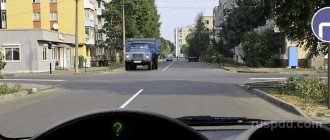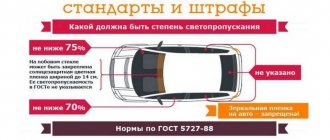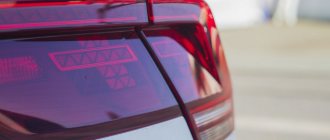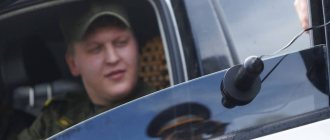Is it possible to remove tint and avoid a fine in 2021?
According to the requirements of the law, the driver is obliged to comply with the legal requirements of the inspector - Part 3 of Article 30 of the Police Law. These are the requirements associated with the collection of evidence in an administrative case. If there are visual signs of a violation (dark glass), then the inspector has the right to demand measurement of their light transmission. Obstruction of measurements - failure to comply with legal requirements with subsequent punishment under Part 1 of Article 19.3 of the Code of Administrative Offenses, up to arrest for 15 days.
Let's trace the chain of legislative acts at the request of the inspector!
- Legal are the demands of traffic police officers that are based not only on their rights and responsibilities, but for which the procedure for exercising rights and responsibilities is determined - part 3 of article 12 and part 3 of article 13 of the Federal Law on Police.
- This procedure is given in paragraph 126 of the regulations, which contains references to paragraphs. 96-99 of the Administrative Regulations for Supervision of the Technical Condition of Vehicles.
- In addition, restriction of the rights and freedoms of citizens is permissible only on the grounds and in the manner established by federal law - Part 2 of Article 6 of the Law “On the Police”.
- The grounds are specified in paragraph 111 of the Administrative Regulations of the State Traffic Safety Inspectorate. We are talking about the presence of signs of an offense under Article 12.5 of the Code of Administrative Offences.
- According to the listed standards, the inspector’s demands to provide a car to measure light transmission are considered legal. And, if the driver, instead of fulfilling a legal requirement, rips off the film, then he is sent to a judge, who makes a decision on punishment under Part 1 of Article 19.3 of the Code of Administrative Offenses.
According to the listed standards, the inspector’s demands to provide a vehicle for measuring light transmission are legal. And, if the driver, instead of fulfilling a legal requirement, rips off the film, then he is quite rightly sent to a judge, who makes a decision on punishment under Part 1 of Article 19.3 of the Code of Administrative Offenses. True, not every removal of film will result in punishment.
Tinting is allowed for a day. When the inspector has the right to demand that the film be torn off
The traffic police proposes to give motorists time to eliminate illegal tinting. Now inspectors have the right to demand that drivers tear off the film that does not comply with GOST standards right at the place where the violation was recorded. And in case of disagreement with the requirement, motorists may be held accountable under a more serious article, even providing for administrative arrest.
According to Part 3.1. Art. 12.5, driving a vehicle with installed windows, the light transmission of which does not meet the requirements of technical regulations, entails an administrative fine in the amount of 500 rubles. At the same time, the actions of drivers who do not agree to eliminate the violation on the spot can be qualified as disobedience to a lawful order of a police officer. According to Art. 19.3 of the Code of Administrative Offences, this is punishable by a fine of 500 rubles. up to 1 thousand rubles or administrative arrest for up to 15 days.
In a number of regions, traffic police inspectors often use Art. 19.3, which leads to conflicts between police officers and drivers. Otherwise, the inspectors themselves say, it is impossible to force persistent violators to comply with the requirements of the law.
The traffic police offers to give a day
To stop this practice, State Duma deputy from the LDPR party Yaroslav Nilov turned to the traffic police for clarification. They said that recently the department has observed a significant increase in offenses related to improper tinting. And they clarified that, according to the police law, traffic police inspectors have every right to demand that drivers stop illegal actions.
Car services Autonews
No need to search anymore. We guarantee quality of services. Always nearby.
Select service
At the same time, in the opinion of the traffic police management, drivers should be given a reasonable period of time to eliminate the violation, it is stated in a letter signed by the head of the department, Mikhail Chernikov: “The corresponding requirements in relation to drivers must be drawn up in writing and contain a reasonable period of time (at least 24 hours), during which such requirement is subject to implementation. Issuing written demands to drivers from the State Traffic Inspectorate to stop illegal actions does not contradict the law, which is confirmed by judicial practice.”
Deputies demand simplification of rules
Yaroslav Nilov himself, in an interview with Autonews.ru, stated that he considers it necessary to completely prohibit inspectors from demanding that incorrect tinting be corrected on site. “If a driver is detained for violating tinting standards, it is illegal to require him to immediately peel off this film. This order must be in writing. Of course, protocols need to be drawn up against violators and fines issued to them,” the deputy said.
When is it not necessary to remove film at all?
Requirements for the light transmittance of rear windows, relevant for 2021, are established in clause 4.3 of the Technical Regulations “On the Safety of Wheeled Vehicles”. And the rear windows can be covered with film without any restrictions. The only requirement is the presence of side rear view mirrors on the right and left.
Front windows must have a light transmittance of 75%, as specified in UN Regulation No. 43. Otherwise means making changes to the design, with subsequent possible termination of vehicle registration. However, in the mentioned paragraph 4.3 of the regulations, a reduction in light transmission of up to 70% is allowed, apparently due to the natural wear of the glass.
If you plan to use the car as a living room in case you are kicked out of the house, and it is constantly parked and does not go on the road, then you can paint over all the windows with black paint. The percentage of light transmission is important only when driving a car, which begins the moment it starts moving.
Thus, tinting is not prohibited in principle, but there are 2 conditions:
- or your car is stationary, and then you can at least board up all the windows with plywood,
- you drive a car, then the tinting together with the glass must transmit at least 70% of the light, otherwise such film must be torn off by law.
You will also be interested in:
- Who is responsible for the car if the driver is picked up by traffic police officers and taken away?
- All about the new warning in the police in questions and answers
- Does a traffic police officer have the right to stop and check the documents of pedestrians and passengers?
The amount of the fine for tinting
What is the fine for tinting front windows today? Article 12.5 of the Code of Administrative Offenses of the Russian Federation warns lovers of tinted car windows that the punishment is a fine equal to five hundred rubles.
In case you do not want to be punished, follow the rules that allow tinting of the following elements of your car:
- rear side windows;
- rear window;
- windshield - only its upper part, using a special colored transparent film, no wider than 14 cm;
- windshield, provided that the light transmittance is less than 70%.
The light transmission of all windows should not be lower than 70%. If this norm is not observed, the traffic police officer has every reason to draw up a protocol against the violator, providing for punishment in the form of a fine.
Amount of fine for driving under a brick. Details here:
How to avoid a fine for tinting?
The most effective way to avoid punishment and penalties is to simply remove all the tinting from your car windows immediately after you are stopped by a traffic police inspector. If the driver fulfills this requirement without argument, the government representative does not make a complaint and refuses to draw up a report.
You can also bypass administrative penalties by using other legal methods:
- the driver can challenge the legality of drawing up the protocol - for example, if the inspector filled out this document without first using special instruments to measure light transmittance;
- the protocol may be invalidated if light transmittance measurements were carried out in bad weather conditions, or on the territory of a traffic police station (in this case, it is necessary to make a video recording that will confirm the correctness of the owner of the tinted car);
- if the protocol is drawn up with errors and significant inaccuracies, it can also be challenged in court.
There is another way to avoid punishment; some drivers resort to it. However, it does not always “work” - you just need to completely lower the car windows before the traffic police officer has time to approach you. It is worth remembering that at the first request of the inspector you will have to lift all the windows back. The safest way to avoid police reprisals is to simply use film whose light transmittance is within normal limits.
To learn about the fine you face if a driver runs a red light, read the link:
We removed the tint before measuring - what happens?
Let's return to our case when the driver removed the tint before measuring its dose of transmitted light. As already mentioned, this threatens the driver with a fine or arrest for up to 15 days under Part 1 of Article 19.3 of the Administrative Code. But everything is not as simple as it seems to police and judges.
As stated, in order to limit the rights and freedoms of a citizen, the federal law must specify the procedure for restriction. For the Code of Administrative Offences, this is Section IV of the Code.
For example, according to the Code of Administrative Offences, to establish the event of driving a vehicle while intoxicated, a protocol of removal from driving a vehicle, an examination report, a protocol of referral for a medical examination are drawn up, and certified by witnesses.
There is nothing similar in the Code of Administrative Offenses to establish the event of an offense related to the technical condition of the car, including those related to tinting.
To be fair, there is no point in focusing particular attention on a trivial omission in the legislation, since all traffic police vehicles are equipped with devices for measuring light transmission, and the loss of drivers’ time on measurements is minimal.
But the situation changes when the device turns out to be faulty or the inspector does not have the device with him. The traffic police officer leaves to look for the device, at the same time smoke, eat, chat, make a call, breathe... And the driver is ordered to wait and not rock the boat. This action in the Code of Administrative Offenses is called detention, which is properly formalized. No registration – the detention is illegal.
Against the background of an illegal detention, the lack of order defined by federal law when measuring light transmission takes on a completely different shade, emphasizing the ignorance of the inspector - one can still agree with a slight violation of the law, but lawlessness is already too much.
Brief information: detention is legal when it takes place:
- base,
- target
- and the motive for the arrest.
If the inspector goes to look for the device, then the motive for the arrest is replaced by the goal - collecting evidence of an offense, which once again proves the incompetence of the policeman. But this is a topic for another article.
If the detention is illegal, then all subsequent actions of the inspector are also illegal. Therefore, removing tinting cannot in any way contradict the requirements of the law. Moreover, if the driver manages to remove the tinting from all windows.
Can you imagine how long it takes to remove film from all glass by an untrained person without any tools? And where was the inspector at that time?! But according to the standards, only 30 minutes are allotted for a complete technical inspection of a passenger car on the road, including measuring the light transmittance of the windows - clause 99 of the regulations on the supervision of the technical condition of vehicles.
By the way, you can read about the measurement rules in our special article.
Can a traffic police officer seize the film and rummage through the car?
All reasons for searching a car are listed in paragraph 202 of the regulations, which fully complies with the requirements of the Code of Administrative Offenses and the Law on the Police. The torn film is neither an object nor an instrument of a crime, just as it is neither a drug nor ammunition. The same applies to the inspection of things in the possession of an individual.
Therefore, the inspector has no right to seize the film and rummage through the driver’s belongings.
Can an inspector detain or arrest?
Arrest is a type of punishment that can only be imposed by a judge. If the driver faces arrest under Part 1 of Article 19.3 of the Code of Administrative Offenses for disobeying the legal demands of the inspector, then the latter has the right to detain him and take him to the magistrate’s court, if the court is open at that moment.
If it is evening or night, then the inspector must have a motive to detain the driver. In order for a person who has a permanent place of residence and who has never hid from any authorities to be shoved into a “monkey box” before trial, the policeman must have an ironclad motive, clearly and clearly stated in the arrest report.
The driver should immediately declare that he is ready to appear in the magistrate’s court at the first request. At the same time, give the exact address of residence, actual place of work, personal telephone number and telephone number at the place of work. This step will confirm that the driver does not intend to hide from justice.
Thus, the arrest is illegal if you removed the tint before the measurement, and there should not be such a penalty for this under the law.
Checking the light transmission of glass on site
In the event of complaints from traffic police inspectors regarding the film applied to car windows, the driver has every right to demand inspection through the use of special technical means.
He can also monitor the serviceability of the equipment, in the absence of which the motorist reserves the right to demand the drawing up of a protocol.
Experts recommend resorting to the same methods if a malfunction of the sensors is clearly visible or the vehicle owner categorically disagrees with their readings, clearly knowing the properties of the tint used on the vehicle.
In all cases, to draw up a protocol, it is necessary to invite two witnesses, without whom the document will not have legal force. At the same time, the search for witnesses is the direct responsibility of the inspector himself, and if he clearly does not want to do this, delaying time in every possible way, then it is time to remind him of Art. 28.5 of the Administrative Code, according to which the drawing up of a protocol is immediate.
In addition, all your disagreements must be written down in the protocol form, otherwise its preparation in the presence of attesting witnesses also loses all meaning. If a violation actually occurs, then the current penalty is 500 rubles.
But in order to issue such a receipt, it is necessary that measurements are made not only using serviceable equipment, but also under certain conditions.
So, at this moment on the street, air humidity should not go beyond the range from 40 to 80% at an atmospheric pressure of 86-106 kPa. There are also certain requirements regarding the temperature, which should be 15-25 degrees Celsius above zero.
Is it possible to rip off and avoid the requirement?
If the light transmission of the glass does not meet the requirements of the Technical Regulations, then the event of an offense under Part 3.1 of Article 12.5 of the Code of Administrative Offenses is established, and either a protocol is drawn up against the driver or an order is immediately issued.
But the policeman has a question: should a driver with tinted windows be released? After all, he will continue to violate the requirements of the law, and such management in itself is unsafe.
To commit an offense, there must be reasons and conditions. In our case, the reason is the application of a tint film. But window tinting in itself is not an offense. For an offense to take place, the driver only needs to start driving. Starting to move, that is, driving a car, is a condition for an offense.
To eliminate the conditions of the offense, the driver with tinting is issued a so-called “Demand to eliminate the conditions leading to the offense.” In itself, such a requirement is illegal - it replaces a warning. But the practice of punishing for failure to comply with the requirement to terminate management in the courts has become established.
In order to avoid having to issue such a paper to the driver, most often in practice in 2021 it is enough to remove the tint from the windows yourself on the spot.
Something else useful for you:
- Is it legal for a traffic police inspector to demand that he get out of the car?
- Requirement for tinting: how to remove it and is it legal?
- Suspension from driving a vehicle in questions and answers
Remove tint on site: is such a requirement legal?
In April 2021, in the city of Ivanovo, Vladimir Sorokin* did not remove the tint from his car at the request of the police right at the place where the inspectors stopped, so they drew up a report against the motorist under Part 1 of Art. 19.3 of the Code of Administrative Offenses (“Disobedience to a lawful order of a police officer”) and sent the case to the Leninsky District Court of Ivanovo.
When considering the case, the car enthusiast insisted that he did not remove the tint in front of the traffic police officers, since he did not have the special knowledge and technical ability to correctly remove the film so that there were no marks left on the glass. But judge Alexander Karpychev (case No. 5-47/2019) decided that this was not a valid reason and ordered Sorokin’s arrest for 5 days.
CASE No. 7-AD19-8
APPLICANT:
VLADIMIR SOROKIN
COURT:
SUPREME COURT
ESSENCE OF THE DISPUTE:
POLICE OFFICERS ILLEGALLY ARRESTED A DRIVER BECAUSE OF REFUSAL TO REMOVE TINTING AT THE STOP SITE
SOLUTION:
JUDICIAL ACTS CANCELLED DUE TO THE LACK OF AN OFFENSE
No special skills required to remove tint
Sorokin filed a complaint with the Ivanovo Regional Court (case No. 12-48/2019). He argued that he needed time to remove the film from the windows, but instead the traffic police officers sent him to the police department and the car to the impound lot. The wife who came to help also did not know how to remove the tint, so the police did it themselves, damaging the glass. Their actions were illegal and caused him harm.
Specialist Vasily Rekunov*, interrogated during the consideration of the complaint, explained that he works in a car repair shop and often applies and removes tint. Sorokin could remove the film on the spot on his own, even without the skills, since the defects could easily be corrected at a car dealership, the expert assured.
The judge of the Ivanovo Regional Court, Nikolai Matveev, decided that even after partially removing the tint, Sorokin could continue the trip, because “the issue of the quality of film removal has no legal significance in the case,” so he left the arrest order in force.
A similar decision was made by the Deputy Chairman of the Ivanovo Regional Court, Elena Mudrova (case No. 4a-261/2019), finding that Sorokin could have gotten rid of the film, but did not do so intentionally in order to obtain an order from the traffic police officers to remove the tint in the future.
VS: Sorokin complied with the policeman’s demands
Supreme Court Judge Sergei Nikiforov noted that the traffic police officer suggested Sorokin take 2 actions: stop the car and remove the tint. At the same time, the driver complied with the policeman’s first demand and did not drive the car with the film again. The fact that the driver did not remove the tint is not grounds for arrest for disobedience, since Sorokin has already stopped the illegal action.
In addition, the Supreme Court found that Sorokin was given only 10 minutes to eliminate defects in the car, and such a period is unreasonable, therefore the demands of the traffic police officers were illegal. The judges of the Supreme Court overturned the decisions of lower instances due to the absence of an administrative offense in Sorokin’s actions.
The Supreme Court's findings are correct and fair. I consider the immediate demand to remove the tint to be illegal, since the driver has the right to appeal the decision to punish the film within 10 days, and the court can cancel it. For example, if a police officer used a light transmittance measuring device not in accordance with the operating instructions. Then the requirement to eliminate violations will not have legal force.
Leading lawyer of the European Legal Service Orest Matsala
*—name and surname have been changed by the editor.
- Marina Kensheva
The policeman demands to eliminate it in front of him - do I have an obligation?
Drivers have a responsibility to comply with legal requirements. These are not only traffic rules, but also the requirements of the Technical Regulations, which set standards for the light transmission of glass.
The driver's reaction time ranges from 0.3 to 1.8 seconds depending on the situation, the driver's condition and other factors. In the dark on unlit roads, the reaction time increases by 0.6-0.7 seconds. For this reason, driving at a speed of 90 km/h at night with low beam headlights is unsafe.
Tinting with light transmission less than 35% increases reaction time by 0.1-0.7 seconds. That is, it is already unsafe to drive a tinted car at high speeds during the day. Driving a tinted car at night is borderline suicidal.
For some time, the driver is saved by excellent knowledge of the road, which reduces reaction time. But one day an unfamiliar object appears in the headlights, its outlines fall on the retina of the eyes, the information goes to the brain, and it begins to recognize. After all, he first needs to decide: is there a danger or not?
The brain solves the problem, time passes, and the driver drives towards an obstacle with the instinct of self-preservation completely turned off.
This is the situation that the requirements of technical regulations prevent. And if a policeman demands that the tint be removed on the spot, then it is better to meet him halfway.
However, there is an alternative option. Driving ends when the need to move is exhausted. This situation occurs if the driver calls a tow truck.
What are the benefits of tinting?
There are many supporters of window tinting who believe that it protects the interior, including leather car covers and plastic, from fading. In hot weather, tinting protects against heat and protects from sun glare. Plus, the interior becomes protected from prying eyes, which is usually the main reason for using tint. However, it also interferes with good visibility from the car, especially at night, which is the cause of many accidents. And it is for this reason that it is undesirable to tint the front windows.
Will the fine for tinting be higher again?
Today there is a rule that allows traffic police officers to more effectively deal with fans of overly tinted cars. The law provides for the preparation of a written warning if a film with low light transmittance is detected on the front windows or the side of the car. As a rule, in such a warning the inspector indicates that the offender must fix the problem and remove the film within ten days.
In case of failure to comply with the legal requirement, the next stop of a tinted car may result in a fine of 1 thousand rubles for its owner. It is also possible to apply administrative arrest, the period of which will be up to 15 days. Drivers who did not pay the previous fine on time will also have to pay the state 1 thousand rubles.
Useful information: What is the penalty for a technical inspection carried out untimely?











